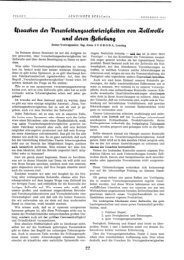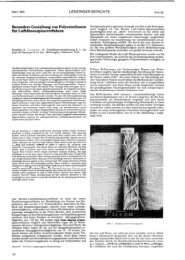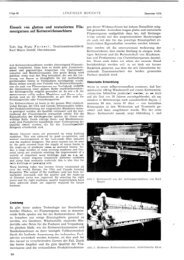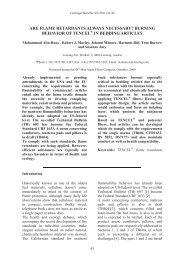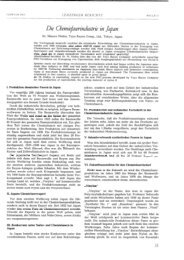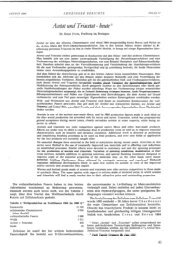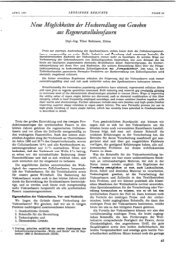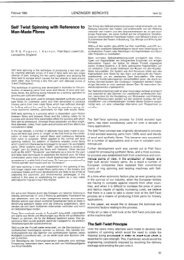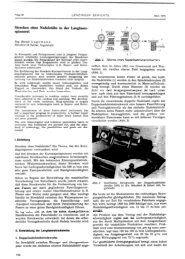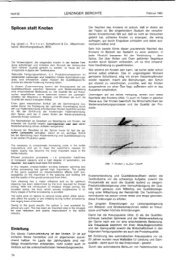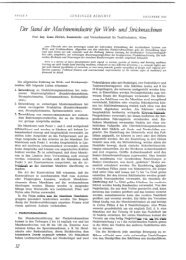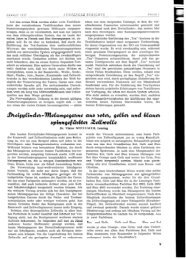Ionic liquid: current developments, potential and ... - Lenzing
Ionic liquid: current developments, potential and ... - Lenzing
Ionic liquid: current developments, potential and ... - Lenzing
You also want an ePaper? Increase the reach of your titles
YUMPU automatically turns print PDFs into web optimized ePapers that Google loves.
network in silk fibroin [137, 138]. Starch was<br />
selectively depolymerised by mixing with 1butyl-3-methylimidazolium<br />
chloride. Stirring<br />
native barley starch at 100°C gave a product<br />
mixture containing monomeric products of<br />
depolymerised amylose, but amylopectin<br />
remained intact. However, all the starch was<br />
converted into monomeric products at 150°C<br />
[139]. This is an interesting example of selective<br />
degradation of biopolymers. [BuImMe]Cl was<br />
also used for the dissolution <strong>and</strong> regeneration of<br />
wool keratin fibers, which can be used to prepare<br />
wool/cellulose blended materials directly [140].<br />
Solubilisation <strong>and</strong> derivatisation of the amino<br />
polysaccharide chitin [141] in RTILs clearly has<br />
<strong>potential</strong> for exciting new products [142, 143].<br />
Certain ILs were proposed for wood preservation<br />
[144, 145, 146]. Impregnation of paper using ILs<br />
as curing agents reportedly decreased strength,<br />
improved wettability, <strong>and</strong> provided resistance to<br />
moulds <strong>and</strong> fungi [147].<br />
Let us take a look at the patent situation: there<br />
are of course numerous patents for ILs, e.g. [148,<br />
149], but only a very limited number concerning<br />
ILs <strong>and</strong> cellulose [150, 151, 152, 153, 154, 155].<br />
It is surprising which patents are granted today,<br />
taking into account that they involve long-known<br />
facts.<br />
Drawbacks<br />
Lack of exhaustive physical parameters such as<br />
conductivity, viscosity etc. are a serious<br />
drawback for the industrial use of ILs at the<br />
moment. The establishment of a comprehensive<br />
database was proposed [156], <strong>and</strong> in 2003, an<br />
international effort was launched through the<br />
IUPAC to meet this important need.<br />
Among the different generations of ILs,<br />
hydrolytically stable yet hydrophobic ILs would<br />
allow easiest recovery from biphasic processes<br />
(such as spinning cellulose fibers into an aqueous<br />
precipitation bath). However, these systems can<br />
obviously be never designed to dissolve<br />
carbohydrate-based macromolecules, since their<br />
solubilisation relies on the competitive replacement<br />
of intermolecular hydrogen bridges which<br />
is only feasible with hydrophilic solvent systems.<br />
Another <strong>potential</strong> problem with ILs is the<br />
possible pathway into the environment through<br />
waste water. However, this situation is common<br />
with every solvent.<br />
<strong>Lenzing</strong>er Berichte, 84 (2005) 71-85<br />
77<br />
Experimental<br />
Synthesis of 1-allyl-3-butylimidazolium chloride<br />
To 99.5 g of freshly destilled 1-allylimidazole<br />
(0.92 mol, 1 equiv.) in a round-bottomed flask<br />
equipped with reflux condenser was added an<br />
excess of 1-chlorobutane (93.7 g, 1.01 mol, 1.1<br />
equiv.). The reaction mixture was refluxed for 24<br />
h. Excess 1-chlorobutane was removed by means<br />
of an oil pump (80°C) yielding 182.7 g of a<br />
slightly yellow, viscous <strong>liquid</strong> (98% of theory).<br />
1<br />
H NMR (CDCl3): δ 1.12 (3H, t, J 7.3 Hz), 1.54<br />
(2H, m), 2.10 (2H, m), 4.50 (2H, t, J 7.3 Hz),<br />
5.13 (2H, d, J 6.3 Hz), 5.65 (2H, m), 6.30 ppm<br />
(1H, m), 7.91 (1H, m), 8.00 (1H, m), 9.38 (1H,<br />
s). 13 C NMR (CDCl3): δ 13.3, 19.3, 32.9, 49.5,<br />
51.7, 122.0 (2C), 122.6, 130.1, 137.0 ppm. IR<br />
(neat, ATR): 3047, 2957, 2934, 2871, 1644,<br />
1561, 1458, 1424, 1163, 994, 942 cm –1 . Mp.: not<br />
crystalline down to –50°C, turns into a glass.<br />
Synthesis of 1-allyl-3-butylimidazolium<br />
dicyanamide<br />
To a solution of 18.5 g 1-allyl-3-butylimidazolium<br />
chloride (0.092 mol, 1 equiv.) in 80<br />
ml acetone were added 8.17 g of sodium<br />
dicyanamide (0.092 mol, 1 equiv.). The<br />
suspension was stirred for 24 h at room<br />
temperature, then sodium sulfate was added. The<br />
mixture was stirred for additional 20 minutes <strong>and</strong><br />
then filtered with suction through a G4 frit. The<br />
solvent was removed by means of a rotary<br />
evaporator <strong>and</strong> the product finally dried on a<br />
vacuum line (oil pump, 70°C, 8 h) yielding 20.7<br />
g of a slightly yellow <strong>liquid</strong> (97% of theory).<br />
1<br />
H NMR (neat, C6D6 external locking capillary):<br />
δ 1.06 (3H, t, J 7.3 Hz), 1.48 (2H, m), 2.04 (2H,<br />
m), 4.44 (2H, t, J 7.3 Hz), 5.07 (2H, d, J 6.3 Hz),<br />
5.59 (2H, m), 6.25 ppm (1H, m), 7.85 (1H, m),<br />
7.94 (1H, m), 9.32 (1H, s). 13 C NMR (neat, C6D6<br />
external locking capillary): δ 13.7, 19.7, 32.2,<br />
49.9, 52.0, 119.9, 121.7, 122.9, 123.2, 131.5,<br />
136.6 ppm. IR (neat, ATR): 3136, 3093, 2961,<br />
2874, 2225, 2191, 2124, 1561, 1461, 1304, 1160,<br />
993, 944 cm –1 .<br />
Synthesis of 1-allyl-3-methylimidazolium<br />
dicyanamide<br />
To a solution of 27.9 g 1-allyl-3-methylimidazolium<br />
chloride (0.175 mol, 1 equiv.) in 80<br />
ml acetone were added 15.6 g of sodium<br />
dicyanamide (0.175 mol, 1 equiv.). The mixture



